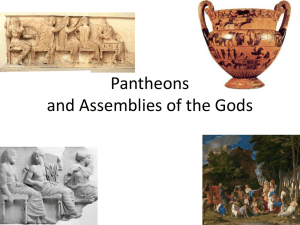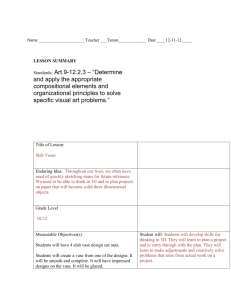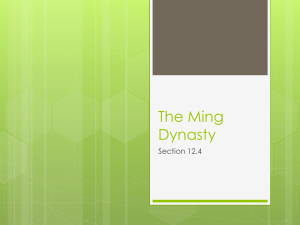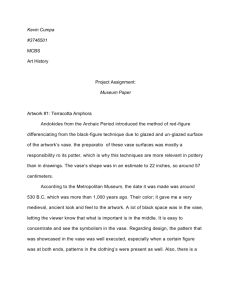Focus constructions
advertisement
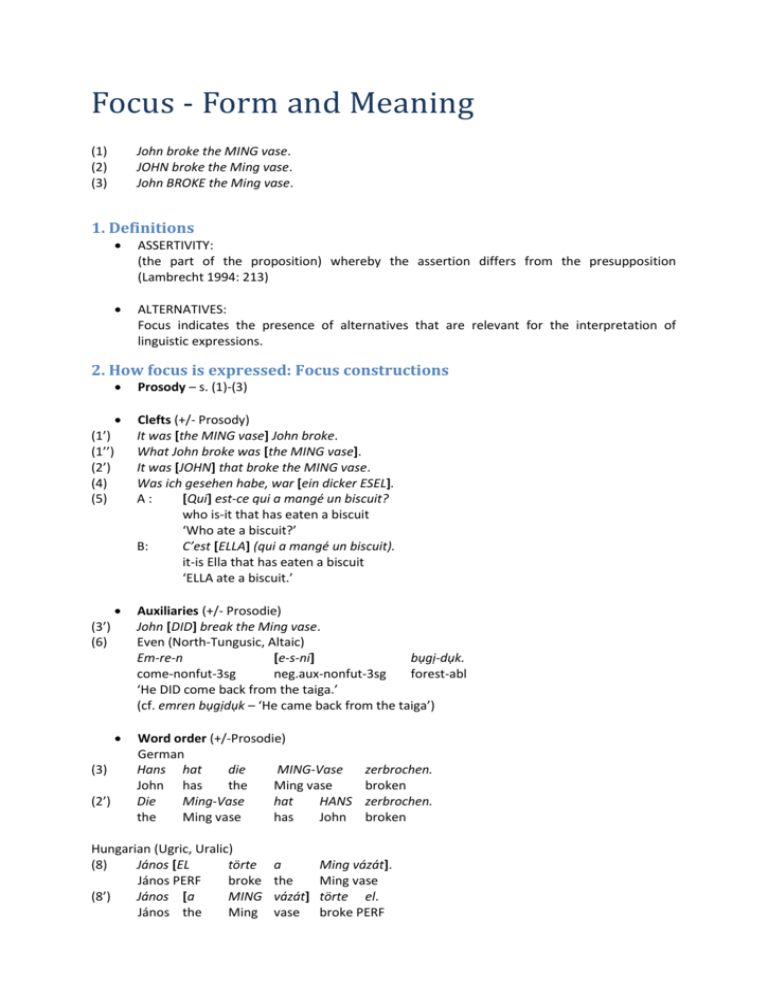
Focus - Form and Meaning
(1)
(2)
(3)
John broke the MING vase.
JOHN broke the Ming vase.
John BROKE the Ming vase.
1. Definitions
ASSERTIVITY:
(the part of the proposition) whereby the assertion differs from the presupposition
(Lambrecht 1994: 213)
ALTERNATIVES:
Focus indicates the presence of alternatives that are relevant for the interpretation of
linguistic expressions.
2. How focus is expressed: Focus constructions
Prosody – s. (1)-(3)
Clefts (+/- Prosody)
It was [the MING vase] John broke.
What John broke was [the MING vase].
It was [JOHN] that broke the MING vase.
Was ich gesehen habe, war [ein dicker ESEL].
A:
[Qui] est-ce qui a mangé un biscuit?
who is-it that has eaten a biscuit
‘Who ate a biscuit?’
B:
C’est [ELLA] (qui a mangé un biscuit).
it-is Ella that has eaten a biscuit
‘ELLA ate a biscuit.’
Auxiliaries (+/- Prosodie)
John [DID] break the Ming vase.
Even (North-Tungusic, Altaic)
Em-re-n
[e-s-ni]
bụgị-dụk.
come-nonfut-3sg
neg.aux-nonfut-3sg
forest-abl
‘He DID come back from the taiga.’
(cf. emren bụgịdụk – ‘He came back from the taiga’)
Word order (+/-Prosodie)
German
Hans hat
die
MING-Vase
John has
the
Ming vase
Die
Ming-Vase
hat
HANS
the
Ming vase
has
John
(1’)
(1’’)
(2’)
(4)
(5)
(3’)
(6)
(3)
(2’)
Hungarian (Ugric, Uralic)
(8)
János [EL
törte
János PERF
broke
(8’)
János [a
MING
János the
Ming
a
the
vázát]
vase
zerbrochen.
broken
zerbrochen.
broken
Ming vázát].
Ming vase
törte el.
broke PERF
(8’’)
[JÁNOS]
János
törte el
broke PERF
a
the
Ming
Ming
vázát.
vase
Specialised Morphology (+/- Prosodie)
Kolyma-Yukaghir (isolate, NE Siberia)
(9)
Ivan [čoqol’-gələ
köjləš-u-m].
Ivan vessel-ACC
break-0-3SG
(9’)
Ivan [čoqol’-ək]
köjləš-mələ.
Ivan vessel-FOC
break-3SG.OBJ.FOC
(10)
Terikə [ke:-č].
old.woman
arrive-3sg
(10’) [Terikə-k]
kel-u-l.
old.woman-FOC
arrive-0-SUB.FOC
3. Focus Semantics
3.1. Theories
ASSERTIVITY (Lambrecht 1994)
(the part of the proposition) whereby the assertion differs from the presupposition
(Lambrecht 1994: 213)
pragmatic presupposition
The set of propositions lexicogrammatically evoked in an utterance which the speaker
assumes the hearer already knows or believes is ready to take for granted at the time of
speech. (52)
pragmatic assertion
The proposition expressed by a sentence which the hearer is expected to know or believe or
take for granted as a result of hearing the sentence uttered. (52)
ALTERNATIVE SEMANTICS (Rooth 1992)
1. Regular Meaning of propositions
[[]]o = p = P(a)
2. Focus meaning:
[[]]f = λx [P(x) | x {a,b,c, etc.}] > P(a), P(b), P(c), etc.
Focus: λxλP [P(x) | x {a,b,c, etc.}]
(11)
John broke [the MING vase].
[[]]o = break(John, Ming vase)
[[]]f = λx [break(John,x)] | x ={Ming vase, Qing vase, Yuan vase}]
> {John broke the Ming vase, John broke the Qing vase, John broke the Yuan vase}
(12)
[JOHN] broke the Ming vase.
[[]]o = break(John, Ming vase)
[[]]f = λx [break(x, Ming vase)] | x ={John, Tom, Peter}]
> {John broke the Ming vase, Tom broke the Ming vase, Peter broke the Ming vase}
The set of alternatives is a subset of the focus meaning
The existence of alternatives is a presupposition carried by the focus
3.2 Truth-conditional and other focus effects, assertivity and alternatives
Questions and answers
(13)
Question: Who called me?
(a) Answer 1: PETER called you.
(b) Answer 2: Peter called YOU. #
(14)
Question: Who did Peter call?
(a) Answer 1: PETER called you. #
(b) Answer 2: Peter called YOU.
>>> Why must the focus in the answer correspond to the question word in the question?
---- Meaning of questions
---- Assertive Interpretation vs. Alternative-based Interpretation
Focus particles (Association with focus)
(15)
Mary only introduced BILL to Sue.
(15’) Mary only introduced Bill to SUE.
---- Do these two sentences have the same truth values?
---- Assertive Interpretation vs. Alternative-based Interpretation
Scalar Implicatures
[Scalar Implicature: Implicatures that are based on the strength of an expression on a scale. When
the speaker can use the stronger expression, he will do it >>> when he uses the weaker expression,
he implicitly negates the stronger one. A typical example: quantifiers {some, all} (‘all’ is stronger than
‘some’). Some students were bored >> ‘Not all students were bored.’
(16)
[Question after an exam in which Anne, Peter and I took part: So, how was it?]
(a) Oh well, Ann PASSED. (+> Ann just managed to pass, she wasn’t really good)
(b) Oh well, ANN passed. (+> Peter and I didn’t pass, we failed.)
---- Assertive Interpretation vs. Alternative-based Interpretation
Conditional clauses
(17)
[Context: Peter has two daughters, Ann and Joan. Joan help Peter in his shop. Peter must
marry his two daughters to the sons of his business partner, Tom, who is younger, and Hans,
who is older. The older son must marry first (seniority); Peter wants to keep Joan with him,
since she helps him in the shop. So he marries Ann to the older son Hans.]
(a)
If he didn’t marry ANN to Hans, Joan couldn’t have helped out any more. TRUE
(b)
If he didn’t marry Ann to HANS, Joan couldn’t have helped out any more. FALSE
(c)
If he didn’t marry ANN to Hans, the rule of seniority would have been broken. FALSE
(d)
If he didn’t marry Ann to HANS, the rule of seniority would have been broken. TRUE
---- Assertive Interpretation vs. Alternative-based Interpretation
4. Problems
(18)
Assertivity
o What kind of presupposition is meant here (semantic or pragmatic)?
o Is the non-focused sentence part always presupposed in the classical sense of the word?
A: You failed to do your homework again!
B: I DID do my homework!
>> neither ‚X did his homework’ nor ‚X didn’t do his homework’ are presupposed, neither
semantically nor pragmatically.
Alternative Semantics and Contrast
o If the presence of alternatives is a precondition for the interpretation of the focused
expression, does this mean that every expression which carries alternatives is focus?
(19)
As far as my uncle is concerned, I visited him; as for my grandmother, I didn’t have time for
her.
(20)
A father was teasing his son.
o
(21)
Does every focused expression evoke alternatives? Do alternatives have a psychological
reality?
(I went for a walk through the forest.) I [heard the birds singing in the TREES.]
>>> Are there alterantives to [heard the birds singing in the trees]?
5. Types of Focus
Scope (Focus size) - narrow vs. broad/wide focus
Almost anything can be focused - from syllables to whole sentences.
(29) (We went to a cave and took a look at the stalagmites.)
Nobody looked at the stalagMITes - everyone was fascinated with stalacTITes.
(30) (Look at the jackets!) I like only the BLUE jacket - the others are ugly.
(31) He gave me [the blue JACKET], although I wanted the yellow trousers.
(32) (What’s your relationship to John?)
He [gave me the blue JACKET yesterday ], so I think I currently like him.
(33) (What’s the matter?)
[My CAR broke down.]
Quality (information focus vs. contrastive focus)
At list since Mathesius (1939), two types of focus are differentiated (cf. É. Kiss 1998):
o ‚normal’, ‚non-contrastive’, ‚new-information focus’
o ‚emphatic’, ‚pathetic [sic!]’, ‚contrastive’, ‚exhaustive’, ‚identificational focus’
(34)
(a) ‚Information focus’(non-contrastive, normal, etc.) I gave you a BOOK.
(b) ‚Identificational focus’(contrastive, emphatic, etc.) It was my BOOK that I gave you.
(35) Hungarian
(a) Meg-adtam neked a
könyvetem. (‚Information focus’)
PERF-gave
you
the book-my
[possible continuation: ‘and also my notebook, my pen, etc.’]
(b) A könyvetem adtam meg
neked. (‚Identificational focus’)
the book-my
gave
PERF
you
[impossible to continue with ‘and also my notebook etc.’ >>> it is for this reason that the
preverbal Hungarian focus is defined as exhaustive - it explicitly excludes all other alternatives,
similar to only]
Definitions:
(a) Information focus expresses new information; identificational focus is an operator quantifying
over closed sets.
(b) The alternative values of the Information focus are unlimited, the alternatives for identificational
focus are restricted to a small number of contextually relevant alternatives.
Problems:
A. conceptual
(a) If they are as different as claimed in (a), why are they both called ‘focus’?
(b) If we accept the definition (b), where is the border between ‘unlimited’ and ‘restricted’ number of
alternatives?
B. empirical
(a) In most cases, the structures that encode ‘Information focus’ can also be used in contexts, in
which ‘Identificational focus’ is used.
(b)Furthermore - the semantic differences claimed to be connected with these two types of focus are
usually not so rigid as they are often claimed to be (Hungarian case).
(c)Typologically - There are languages that have only one focus construction (e.g. Yukaghir), and
there are languages that have very rich systems of five or ten focus constructions (Aghem). The
dichotomy ‘information’ vs. ‘identification’ cannot cover either of these cases.
A possible solution (s. Zimmermann 2007)
The impression of ‘emotional’, ‘contrastive’, etc. focus is derived from pragmatic principles.
-- If a language has more than one focus construction, one of them is usually formally more complex
(‘marked’) than the other(s).
-- If a speaker wants to present an assertion as unexpected, contrastive, exhaustive, etc., he will use
the more complex construction.
-- One the basis of pragmatic principles (more effort in decoding >> more complex message), the
hearer derives the inference that the use of a more complex construction indicates a more complex
message that needs to be pragmatically enriched, as contrastive, emphatic, etc.
-- As with all pragmatically triggered decisions, the use of the one or the other form is partially
optional.


